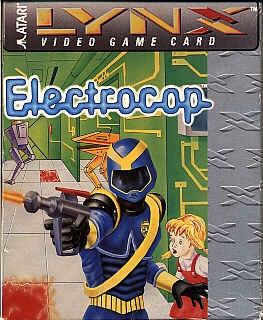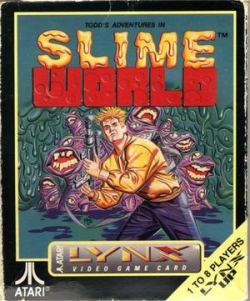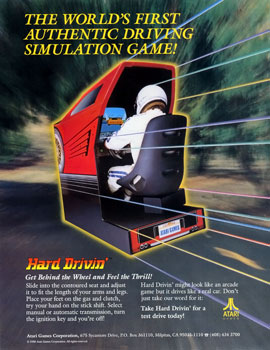
The Atari 7800 ProSystem, or simply the Atari 7800, is a home video game console officially released by Atari Corporation in 1986 as the successor to both the Atari 2600 and Atari 5200. It can run almost all Atari 2600 cartridges, making it one of the first consoles with backward compatibility. It shipped with a different model of joystick from the 2600-standard CX40 and Pole Position II as the pack-in game. Most of the announced titles at launch were ports of 1981–1983 arcade video games.

Area 51 is a light gun arcade game released by Atari Games in 1995. It takes its name from the military facility. The plot of the game involves the player taking part in a Strategic Tactical Advanced Alien Response (STAAR) military incursion to prevent aliens, known as the Kronn, and alien-created zombies from taking over the Area 51 military facility.

Ms. Pac-Man is a 1982 maze arcade video game developed by General Computer Corporation and published by Midway. It is a spin-off sequel to Pac-Man (1980) and the first entry in the series to not be made by Namco. Controlling the title character, Pac-Man's wife, the player is tasked with eating all of the pellets in an enclosed maze while avoiding four colored ghosts. Eating the larger "power pellets" lets the player eat the ghosts, who turn blue and flee.

Rampart is a 1990 video game released by Atari Games and Midway Games that combines the shoot 'em up, strategy, and puzzle genres. It debuted as an arcade game with trackball controls, and was ported to home systems. It had a limited US release in October 1990, and a wide release in early 1991. It was distributed in Japan by Namco.

Klax is a puzzle video game released in arcades in 1990 by Atari Games while Namco distributed the game in Japanese markets. It was designed and animated by Mark Stephen Pierce with the software engineering done by Dave Akers. The object is to catch colored blocks tumbling down a machine and arrange them in colored rows and patterns to make them disappear. Klax was originally published as a coin-op follow-up to Tetris, about which Atari Games was in a legal dispute at the time.

APB is a video game released in arcades by Atari Games in 1987. The player assumes the role of "Officer Bob," a rookie police officer. As Bob, players drive around the city, ticketing motorists for minor infractions and pulling over more serious offenders. Eventually, players must apprehend criminals for which an all-points bulletin has been called.

Pac-Land is a 1984 side-scrolling arcade platform game developed and released by Namco. It was distributed in North America by Bally Midway, and in Europe by Atari Games. Controlling Pac-Man, the player must make it to the end of each stage to return a lost fairy back to its home in Fairyland. Pac-Man will need to avoid obstacles, such as falling logs and water-spewing fire hydrants, alongside his enemies, the Ghost Gang. Eating large flashing Power Pellets will cause the ghosts to turn blue, allowing Pac-Man to eat them for points.

Paperboy is an arcade action game developed and published by Atari Games, and released in 1985. The player takes the role of a paperboy who delivers a fictional newspaper called The Daily Sun along a street on his bicycle. The arcade version of the game featured bike handlebars as the controller.

Rampage is a 1986 arcade video game by Bally Midway. Inspired by monster films, players control a trio of monsters: George, Lizzie, and Ralph, humans turned into creatures due to various experimental mishaps. The objective is to destroy cities and combat military forces while maintaining their health. The game is set across 128 days in cities across North America, with each cycle repeating five times. Gameplay includes destroying buildings, eating humans, and avoiding damage.

Blue Lightning is a 1989 combat flight simulation video game developed by Epyx and published by Atari Corporation in North America and Europe for the Atari Lynx. It was also released in Japan on December 1 of the same year, where it was instead distributed by Mumin Corporation. It was one of the launch titles that were released along with the system in North America and was jointly written by Stephen Landrum, lead programmer Brian Bowhay, who also developed the Lynx hardware and Chip's Challenge creator Chuck Sommerville.

Basketbrawl is a sports video game released for the Atari 7800 in 1990, then for the Atari Lynx in 1992. It is a basketball simulation which allows hitting and fighting with other players. The name is a portmanteau of basketball and brawl. It is similar to the 1989 Midway arcade game Arch Rivals which had the tagline "A basket brawl!"

Rygar is a side-scrolling platform game created by Tecmo in 1986 and originally released for arcades in Japan as Argos no Senshi. The player assumes the role of a "Legendary Warrior", battling through a hostile landscape. The main feature of gameplay is the use of a weapon called the "Diskarmor", a shield with a long chain attached to it.

Gauntlet: The Third Encounter is an arcade-style dungeon crawler role-playing game developed by Epyx and published by Atari that was released for the Atari Lynx handheld system in 1990. Despite using the same packaging artwork that was used for the NES version, The Third Encounter is not a port of the original Gauntlet or its sequel, but instead is a new game developed specifically for the Lynx. It was originally titled Time Quests and Treasure Chests, but it was changed when Atari picked up the license for the Gauntlet franchise from Atari Games.

RoadBlasters is a combat racing video game released in arcades by Atari Games in 1987. In RoadBlasters, the player must navigate an armed sports car through 50 different rally races, getting to the finish line before running out of fuel.

Zarlor Mercenary is a vertically scrolling shooter for the Atari Lynx handheld console, developed by Epyx and published by Atari Corporation.

Electrocop is a 1989 action video game developed by Epyx and published by Atari Corporation in North America and Europe for the Atari Lynx. It was released in Japan on November 25 of the same year, where it was distributed by Mumin Corporation. One of the first games written for the platform, it was one of the launch titles that were released along with the system in North America.

Todd's Adventures in Slime World is a side-scrolling platform video game first released for the Atari Lynx in 1990, with Sega Genesis and PC Engine Super CD-ROM² versions following in 1992.

S.T.U.N. Runner is 3D racing/shooter game released in arcades by Atari Games in 1989. The player pilots a futuristic vehicle which can exceed 900 mph, through various tunnels and courses with changing environments, hazards and enemies. S.T.U.N. Runner uses polygonal graphics for the vehicles and track, and is based on an evolution of Atari's Hard Drivin' hardware. The custom cabinet was designed to resemble the craft that the player pilots in-game.

Hard Drivin' is a sim racing arcade video game developed by Atari Games in 1989. Players test drive a sports car on courses that emphasize stunts and speed. It features one of the first 3D polygon driving environments via a simulator cabinet with a haptic vibrating steering wheel and a custom rendering architecture.

Xybots is a 1987 third-person shooter arcade game by Atari Games. In Xybots, up to two players control "Major Rock Hardy" and "Captain Ace Gunn", who must travel through a 3D maze and fight against a series of robots known as the Xybots whose mission is to destroy all mankind. The game features a split screen display showing the gameplay on the bottom half of the screen and information on player status and the current level on the top half. Designed by Ed Logg, it was originally conceived as a sequel to his previous title, Gauntlet. The game was well received, with reviewers lauding the game's various features, particularly the cooperative multiplayer aspect. Despite this, it was met with limited financial success, which has been attributed to its unique control scheme that involves rotating the joystick to turn the player character.



















